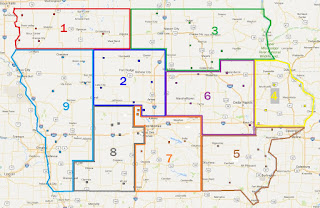In the past, I've also done those maps in a little different way. I call it a "web" map, with lines drawn around the outermost members of a district and connections to other schools inside that line. I think it's actually a bit more accurate visual depiction of the travel involved for district schools - just the boundaries can take in a lot of real estate where there might not be any schools located, whereas this is just lines connecting all the district members. It also really points out where the state does some hinky things.
I already used this method in posting the 4A maps in my previous post, so let's start with 3A:
Right away you see the weird stuff they did with D-5 and D-6. Solon travels across the path of D-5 members CCA and Liberty on their way down to Keokuk and Mount Pleasant. Odd. D-8, of course, is extremely compact (no way around that, really, with the concentration of schools around central Iowa). Solon gets the gut-punch here, though.
Let's look at 2A:
D-1 and D-7 get a bit lucky with travel here. The other seven districts all cover a lot of territory. That Nevada or Gilbert-to-Benton run in D-7 will be a lot better in a decade or so, once Highway 30 gets turned into four lanes all the way.
Here's 1A:
Not too much to see here. It's a bit strange to see Pocahontas Area in D-2 while both Woodward Academy and Woodward-Granger are in D-7 (they're practically on top of each other) but at least they're not crossing each other like with 3A.
And now, A:
More members, so an extra district for Class A. These seem about as compact as you'd be able to make them.
----------
I want to talk a little about the RPI, and how it's going to make non-district games even more important than district games, in general. Obviously your own team's performance continues to be the top factor, as it should be. Heck, win all 5 of your district games and you're in the playoffs, no matter what happens (even if you're 5-4 overall). But for those teams fighting for the 7 (or whatever number) wild card spots, the results of your non-district games (and the non-district games of your other district members) are what's going to be the difference.
With 6-team districts, at the end of the season the district's overall winning percentage must be .500. It just is ... there will be 15 wins and 15 losses total in all district games. So, a team finishing 4-1 in the district (.800 winning percentage) will see their district opponents' win percentage at .440 (11-14). If you finish 3-2, .600, the rest of your district will be 12-13, .480. These numbers will ALWAYS be true, for EVERY district with 6 members across the state. Therefore, the district contribution to 75% of your RPI is unchanging, based on how you do in the district. A team in D-2 that finishes 4-1 in their district will have the exact same amount of RPI from their district games as a team that's 4-1 in D-7, or D-1, or any other district. It doesn't matter if you've got two teams at 4-1, or two or three teams at 1-4 ... every team across the state with an identical district record is tied in RPI as far as district games go.
So the only thing that's going to actually change RPI (for those teams with identical district records) is non-district games. Obviously doing better in the non-district to get a better overall record is the main thing (8-1, 4-1 in a district is getting a winning percentage boost over going 6-3, 4-1). But what you also want is for your other district members to do well in their non-district games, which increases their winning percentage, which helps your RPI.
Now in the big scheme of things this isn't rocket science. You want to make the playoffs and get a good seed? Win your games, that'll still do it. But the RPI also introduces this incentive to root for the other teams in your district to do well in non-district games, because it will help everybody's RPI. A district that has more teams going 3-1 or better in non-district games is going to have a big RPI advantage over a district with multiple teams going 0-4 or 1-3.
Anyway, outside of actually winning the district title, your district games turn out to be actually less important (sort of) than how your entire district does in non-district games. Just seems interesting, I think. But I'm weird that way.








